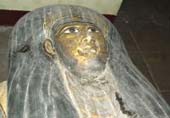Stela depicting Cleopatra as male pharaoh discovered in China

Researchers from Leuven and Beijing have retrieved great part of a unique Egyptian collection
Discoveries in Egypt may be extremely surprising sometimes. In Beijing, an international joint research group from the Catholic University in Leuven and Beijing University discovered a collection of Egypt art that was believed lost for many years already. A Chinese ambassador to Cairo compiled the collection in 1906; when he died the items of the collection were distributed between the Beijing University Museum, the Arts Museum in Beijing and Beijing National Library.
Chinese Ambassador Duan Fang wanted to exhibit the collecting in Europe, but failed to do it because of the revolution. The diplomat who took keen interest in Egypt cultures, one of the few intellectuals in China, was killed in 1911. After his death, the collection was scattered about various museums and some items were even lost.
A year ago, Professor Willy Clarysse from the University of Leuven agreed to study a stela kept at the Beijing University Museum and allegedly belonged to Duan Fang collection. The study gave rise to forming the inventory of the whole of the unique collection. Discovery of the lost items are to be continued next year.
The find consists of over 50 stelae and 60 rubbings made with coal on paper. A special find is a stela which depicts Cleopatra as a male pharaoh. This is the second known example of such a depiction. Majority of the retrieved collection are items belonging to the Greek-Roman epoch.
The first exposition of the retrieved collection items began at the Beijing Museum August 25. Professor Clarysse hopes the exhibition will very interesting for visitors and help find more items of the unique collection that are probably lost somewhere on museum shelves.
Victor Solkin as based upon Leuven University publications
Photo by Willy Clarysse
Subscribe to Pravda.Ru Telegram channel, Facebook, RSS!




